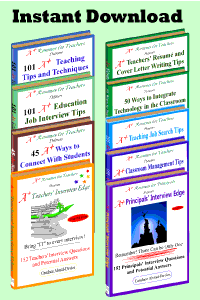As you all know, when learning is fun, it’s meaningful and enjoyable. How would you respond if asked this job interview question?
How do you make learning fun?
Check out these ideas on what to communicate in a job interview or meeting when you asked the question.
It helps students remain attentive and will motivate and make them happy to be in the classroom. An unmotivated student will not be willing to learn as much as a motivated student. Learning how to motivate students will make your teaching job easier.
To help students, adolescents, and adult learners learn, better create fun and creative activities. These activities will help students relax, break down the emotional filter, and focus in the classroom.
I will make learning fun by incorporating many creative and engaging activities throughout my lessons and using various teaching methods to reach all learners. When beginning a new topic or unit to teach, I plan to have the students immersed in the topic right from the beginning. For instance, I decorate my classroom related to the theme I am teaching, such as dinosaurs. I start a topic or unit by playing an entertaining DVD that relates to the topic.
Incorporating group projects where students have to work together to develop something related to the topic works very well. By making learning interactive, actively engages students and raises their interest in the current topic or unit.
Using various learning materials to compliment my teaching helps engage students to keep them focused on the content. Apart from textbooks, I count on numerous sources for making my class fun: newspaper articles, audio texts, role-play activities, films, music, educational games, group work, experiments, field trips, guest speakers, and quiz games.
Challenging students by providing hands-on, dynamic activities that require critical thinking skills such as problem-solving, riddles, or reading comprehension questions sparks student interest and gets them thinking.
Sometimes allowing these activities to be performed in groups creates more interaction between students and enforces the power of teamwork. These cooperative learning activities allow for more interaction between students, letting them learn through listening and speaking or even teaching each other.
Additionally, the integration of technology can help students to learn. Digital photography, video recordings, and internet games and quizzes provide practical learning experiences in a fun and engaging platform.
Finally, allowing students to use their imagination actively will always be fun. I engage my students in role-playing, creating stories, theater productions, and computer-based creative simulations to help students create, think, problem-solve, and use their imaginations while having fun learning and retaining important concepts.
How Do You Make Learning Fun to Increase Students’ Success? Share on X
Often, all of the attention to make learning fun is focused on elementary and early childhood education ages; however, there is no reason why learning can’t be fun in the older grades. In fact, it should be! Since we know students learn better when they are having fun, it is imperative that learning is fun for the older grades and improves outcomes.
Ways to Make Learning Fun for Different Age Levels
Early Childhood Education:
Young children learn best when they are having a good time in a safe environment. Play-based learning is crucial at a young age. Learning through games allows young children to build critical skills in math and reading while not even realizing they are actively learning. Even so, learning through fun activities, active play, and games breeds positive attitudes towards learning and school.
In addition to learning basic academic skills, young children will also develop social and emotional skills through sharing and cooperating with other children during these activities. Some activities that you can incorporate into learning include rhyming games, singing songs, alphabet blocks or magnets, drawing/painting/playdough/coloring, counting games, math manipulatives, sorting objects, etc.
Elementary Grades:
There are lots of opportunities to make learning fun in the elementary classroom – for all subject areas. With the advancement of classroom technology, there are tons of resources to participate and enjoy learning actively. By including hands-on activities in learning stations, cooperative learning groups, centers, and think-pair-share, students can actively participate in groups to learn, solve problems, and have fun.
Incorporating technology into the classroom also provides a myriad of ways to make learning fun for students. Using iPads, computers, or SMART Boards allows for learning to become hands-on and game-like. Virtual field trips, classroom apps, and technology to motivate reading and learning games are all great ways for students to actively learn while having fun.
High School Students:
Learning at this age can quickly become difficult, boring, and tedious if not enough effort is put into making learning active, engaging, and fun. There is no reason you can’t teach difficult concepts in a fun and enjoyable way. It just takes more creative methods.
Teenagers still enjoy a good game, group project, or problem-based learning activity that allows them to participate actively and changes up the lecture-based learning atmosphere. For instance, you can make test review fun by utilizing games like jeopardy, trivial pursuit, sink or swim, or class head. Teenagers love competition, and this is an excellent way to get students excited about reviewing valuable content.
Science Classroom
The science classroom offers lots of great hands-on learning opportunities to engage older students. Exciting experiments can be done everywhere from inside the school lab to outside on the school grounds keeps learning fun. Math can be made more enjoyable by having students actively solve problems by creating real-life learning situations or solving equations of everyday objects or situations.
English and Social Studies
English and social studies courses can incorporate technology, group projects, role-playing, guest speakers, presentations, etc. For instance, have students conduct a Shakespeare play, re-enact historical events, or have students research and prepare for a debate.
College/University/Higher Education:
College courses often rely heavily on lecture-based learning. This doesn’t mean, however, that you can’t incorporate some fun once in a while to help students retain important concepts and apply their learning. Group projects, group presentations, case studies, real-world scenarios, and problem-based learning activities will help students retain the material better while helping them prepare for the real world.
Strive to be a strong role model for your students to optimize the learning experience for each student.
How do you make learning fun in your classroom?
The response you give in a job interview is important to the position and shows value to the school district.


